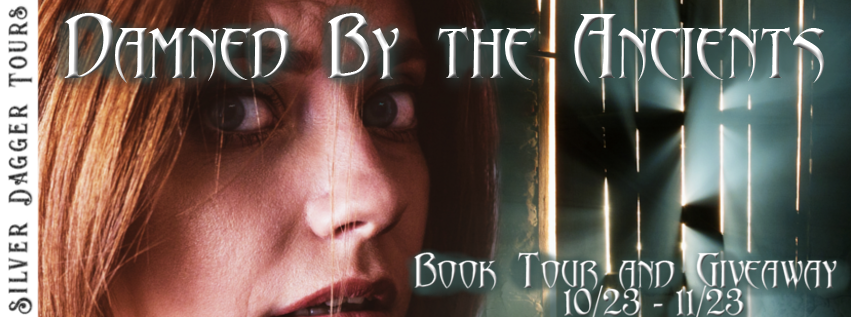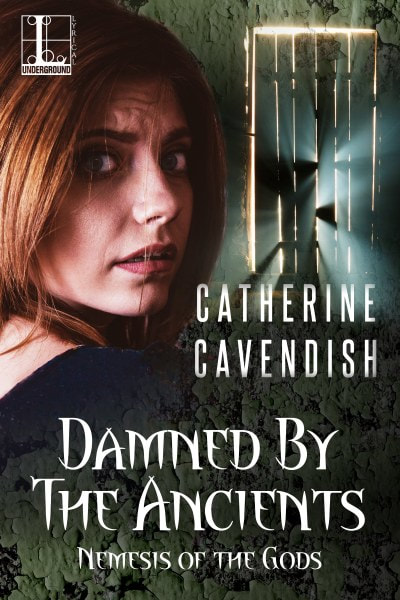Damned by the Ancients
Nemesis of the Gods #3
by Catherine Cavendish
Genre: Horror
Pub Date: 10/23/18
Infinity In Death
Vienna, 1908
Gabriele Ziegler is a young art student who becomes infatuated with
charismatic archeologist Dr. Emeryk Quintillus. Only too late does
she realize his true designs on her. He is obsessed with resurrecting
Cleopatra and has retained the famed artist Gustav Klimt to render
Gabriele as the Queen of the Nile, using ashes from Cleopatra’s
mummy mixed with the paint. The result is a lifelike portrait
emitting an aura of unholy evil . . .
Vienna, 2018
The Mortimer family has moved into Quintillus’s former home, Villa
Dürnstein. In its basement they find an original Klimt masterpiece—a
portrait of Cleopatra art scholars never knew existed. But that’s
not all that resides within the villa’s vault. Nine-year-old Heidi
Mortimer tells her parents that a strange man lives there.
Quintillus’s desire to be with Cleopatra transcends death. His spirit will not
rest until he has brought her back from the netherworld. Even if he
has to sacrifice the soul of a child . . .
Waking the Ancients
Nemesis of the Gods #2
Egypt, 1908
University student Lizzie Charters accompanies her mentor, Dr. Emeryk
Quintillus, on the archeological dig to uncover Cleopatra’s tomb.
Her presence is required for a ceremony conducted by the renowned
professor to resurrect Cleopatra’s spirit—inside Lizzie’s body.
Quintillus’s success is short-lived, as the Queen of the Nile dies
soon after inhabiting her host, leaving Lizzie’s soul adrift . . .
Vienna, 2018
Paula Bancroft’s husband just leased Villa Dürnstein, an estate once
owned by Dr. Quintillus. Within the mansion are several paintings and
numerous volumes dedicated to Cleopatra. But the archeologist’s
interest in the Egyptian empress deviated from scholarly into
supernatural, infusing the very foundations of his home with his dark
fanaticism. And as inexplicable manifestations rattle Paula’s
senses, threatening her very sanity, she uncovers the link between
the villa, Quintillus, and a woman named Lizzie Charters.
And a ritual of dark magic that will consume her soul . . .
Wrath of the Ancients
Nemesis of the Gods #1
DESTINY IN DEATH
Egypt, 1908
Eminent archeologist Dr. Emeryk Quintillus has unearthed the burial chamber
of Cleopatra. But this tomb raider’s obsession with the Queen of
the Nile has nothing to do with preserving history. Stealing sacred
and priceless relics, he murders his expedition crew, and
flees—escaping the quake that swallows the site beneath the desert sands . . .
Vienna, 1913
Young widow Adeline Ogilvy has accepted employment at the mansion of Dr.
Quintillus, transcribing the late professor’s memoirs. Within the
pages of his journals, she discovers the ravings of a madman
convinced he possessed the ability to reincarnate Cleopatra. Within
the walls of his home, she is assailed by unexplained phenomena:
strange sounds, shadowy figures, and apparitions of hieroglyphics.
Something pursued Dr. Quintillus from Egypt. Something dark, something hungry.
Something tied to the fate and future of Adeline Ogilvy . . .
The Knutsford Highwayman
The same observations could be made of today’s subject. Edward Higgins – known as “Squire” Higgins to his friends – was a member of the gentry of Knutsford, an ancient small town some fourteen miles from the major city of Manchester, and lying in the gentle Cheshire countryside. His home, for a time, was in Heath House, just a few doors from the house that would become Victorian novelist’s Elizabeth Gaskell’s home. She even wrote about him in a short story called The Squire’s Tale.
On April 21st, 1757 he married Katherine Birtles whom he kept in blissful ignorance of the true source of his wealth. As far as she was concerned he earned money from rents he charged on properties he owned.
Higgins led the life of a country gentleman, riding to hounds and owning several horses. He fathered five children and, by all reports, was a good father and husband. He and Katherine dined out a lot with neighbours yet Higgins remained of fit and athletic build. He would need to be.
He was also never one to miss an opportunity. Out walking in Chester city centre late one night, he saw a ladder, leaning against the wall of a house. He climbed up it and let himself into a bedroom where a young woman lay sleeping. Evidently she had arrived home late after a ball and had left her jewellery scattered all over the dressing table. Higgins quietly pocketed it and then froze. The young woman turned over in bed. Many years later, he said. “Had she awaked I would have had no choice but to murder her.”
But it was not sufficient for him to rob neighbours. Higgins was after much larger fry. Late at night, he would muffle his horse’s hooves and set out along the dark and treacherous Chester Road, holding up coaches. He found his highwaymen activities easier and far more lucrative as travellers at that time would carry a few guineas with them in case of being held up. It saved a lot of unpleasantness!
Higgins began to work further from home. He returned from Bristol with hundreds of Spanish dollars which he proceeded to use but the circulation of so much Spanish money in such a confined area arose suspicion, including that of a local gossip to whom Higgins is supposed to have told of a man being robbed in Bristol. The gossip soon became suspicious of the real identity of the robber and word spread.
In 1764, Higgins robbed a house in Gloucester and was traced back to his home in Knutsford. Police came to arrest him but naively gave him leave to go upstairs to pack a few things. Needless to say, the ever-resourceful Higgins saw his chance and escaped. The police did not recapture him. He got word to his wife to sell the house and join him – ironically instructing her not to lose the board that hung over the dining room fireplace. On it, in gold letters, were painted the words, ‘Do Not Steal’.
Higgins was hanged at Carmarthen on 7th November 1767, but his story does not end there.
The sound of muffled hooves and the sight of him riding his horse through the streets of Knutsford have been reported by a number of people. Other have recorded sightings of him searching for a likely coach to hold up and, late at night, a phantom coach has been seen and heard moving outside the Royal George Hotel. This is also said to be Higgins. For a ghost, he is pretty busy.
In Damned by the Ancients, Quintilllus doesn’t have to travel far to find his victims. They are already there.
Following a varied career in sales, advertising and career guidance, Catherine
Cavendish is now the full-time author of a number of
paranormal, ghostly and Gothic horror novels, novellas and short
stories. She was the 2013 joint winner of the Samhain Gothic Horror
Anthology Competition, with Linden Manor, which was
featured in the anthology What Waits in the Shadows.
Cat’s novels include The Pendle Curse, Saving Grace Devine,
and Dark Avenging Angel. She lives with her
long-suffering husband and black (trainee) cat. They divide their
time between Liverpool and a 260-year-old haunted apartment in North Wales.

















No comments:
Post a Comment